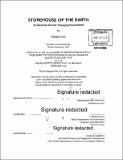Storehouse of the Earth : to document the fast-changing environment
Author(s)
Kim, Namjoo, M. Arch. Massachusetts Institute of Technology
DownloadFull printable version (35.11Mb)
Other Contributors
Massachusetts Institute of Technology. Department of Architecture.
Advisor
J. Meejin Yoon.
Terms of use
Metadata
Show full item recordAbstract
In the book Silent Spring, Rachel Carson argues that humans are one species that could modify its surroundings so drastically as to cause damage to the Earth. Currently, as a consequence of accumulated modification, the rapidity of environmental change accelerates and causes hazards all over the world. Though the earth is always changing, the current speed of change is unprecedented and problematic. The site of this thesis, the Rhone glacier and surrounding area, shows the drsatic speed of change. The Rhone glacier, 11,500 years old, is one of the oldest glaciers in the Alps. However, scientists estimate that this glacier, along with 94% others in the Alps, will disappear in 100 years due to climate warming. When the environment changes slowly flora and fauna can adapt to the change. However, species that are vulnerable to small changes become extinct. Numerous disciplines document the alarming changes taking place including art, science, photography, and film. Each uses unconventional methods to document the rapidly-changing world. I call this new type of documentation culture the "culture of capture." Its preconditions are [1] a shared concern about the extinction of species and the loss of the landscape and [2] the use of new technology to document every detail of change. This thesis argues that architecture is a unique medium that can both document the changing environment as well as have a positive impact on the physical form. I propose two architectural interventions: a 'glacier blanket' and a 'mountain hat' to delay change and to archive the physical remnants of the melting glacier and nival plants. The future scenario of the site, which consists of four aspects, Glacier retreat, Bio-Diversity, Tourism, and Infrastructure, is complicated and constantly varying. The architectural documentation will also be an intricate system that adapts its function and form.
Description
Thesis: M. Arch., Massachusetts Institute of Technology, Department of Architecture, 2016. Cataloged from PDF version of thesis. Includes bibliographical references (pages 136-138).
Date issued
2016Department
Massachusetts Institute of Technology. Department of ArchitecturePublisher
Massachusetts Institute of Technology
Keywords
Architecture.